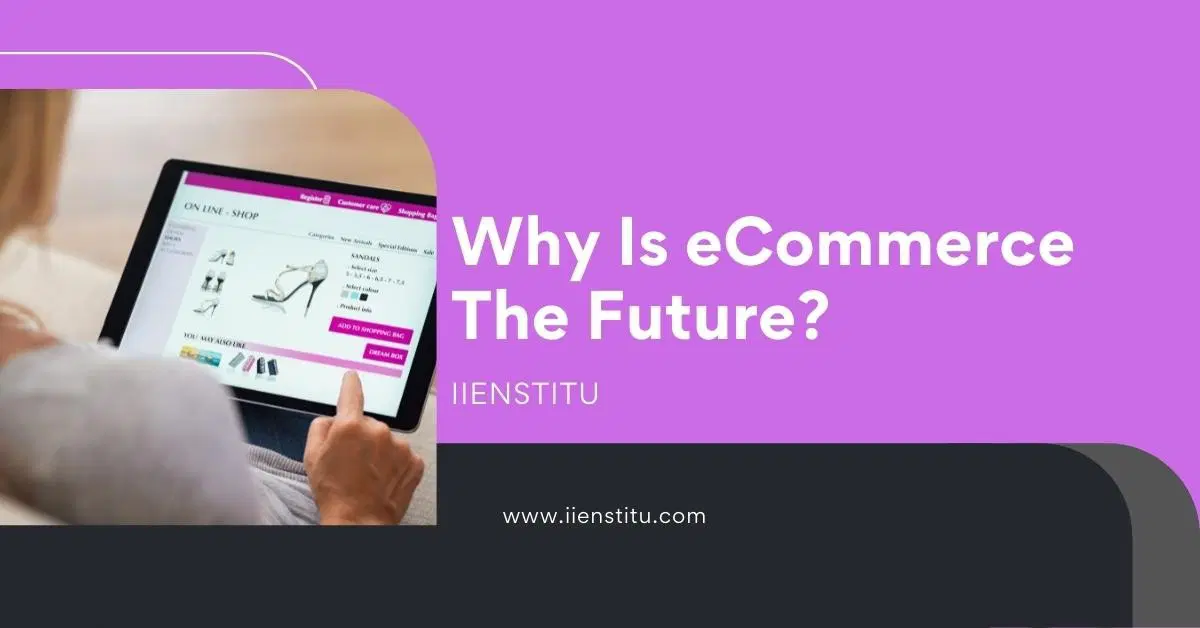
E-commerce is growing more than ever right now because people love to shop on their home computers while drinking coffee, eating breakfast or before they go to sleep at night. It's so convenient for people who are busy with their day-to-day lives and don't have enough time in the morning or afternoon to step out of their houses looking for new items or groceries they may need. And if you work from home like me, these shopping sites are your best friend! I use Amazon's One Hour delivery service, which delivers products within 60 minutes after I purchase them online - my life is becoming easier every second I spend money on it! :)
E-commerce is beneficial for both buyers and sellers. Consumers love online shopping because of its convenience, while some large companies see it as a way to get new customers on board with their products. It's not hard for customers to get highly excited about the potential of finding something new for their wardrobe, home, or office space when browsing sites like one-dollar deals or Best Buy Sales.
And eCommerce has only been growing more significant over the past few years! Who knows where this industry could go? I predict that it will continue expanding until everyone can buy anything without having to step out of their homes - wouldn't that be great? With this convenience, businesses would also be more opportunities to sell different types of products online. Plus, money-saving platforms like these and many more continue to be used and shared with friends and family worldwide. That is why I know that eCommerce is just getting started! It's only going to grow bigger and better after another few decades of progress until we're all living inside virtual reality - then we can download anything we want from a website on our headsets or watches. Or perhaps it will become something even more significant than what we see today. Who knows? What do you think eCommerce will look like in 5 years?
Summarize
1. What are the benefits of eCommerce over traditional retail?
2. How does eCommerce change how business works?
3. Is there a downside to eCommerce that we should be worried about?
What are the benefits of eCommerce over traditional retail?
There are many benefits of eCommerce over traditional retail. For starters, eCommerce allows customers to browse a more comprehensive selection of products than they would be able to find in a physical store. In addition, online stores can be updated with new products much more quickly than traditional stores, so customers can always find the latest and most significant items.
eCommerce also offers greater flexibility than traditional retail. For example, online stores can customize to fit each customer's specific needs, while conventional stores limit their physical space. In addition, customers can shop for products online any time of the day or night, whereas traditional stores are only open during specific hours.
Finally, eCommerce is often more affordable than traditional retail. That is because eCommerce businesses typically have lower overhead costs than brick-and-mortar stores. Additionally, online stores can offer discounts and special deals that aren't available in traditional stores.
How does eCommerce change how business works?
Many people interested in shopping online run it like a comparison, where they go through several different websites and platforms before settling on one to buy. It means that eCommerce is changing how businesses work because it brings new ways for companies to interact and deal with customers. For example, E-commerce platforms allow individuals to communicate directly with online stores or brands, enabling them to share their thoughts and feelings about the products they bought from the company. In this sense, these interactions can influence both purchasing habits and what brands come into being over time.
In addition, customers have been saying that they feel more comfortable when shopping online than when going into physical stores. That could be because web users don't have to worry about the embarrassment of asking a salesperson for help most of the time. Instead, they can take their time to find what they are looking for on the internet without feeling rushed or pressured. It could be another reason why eCommerce is changing how business works, as companies now have to compete with online stores that provide a comfortable and convenient shopping experience.
It's important to note that not all businesses have transitioned to eCommerce successfully. For example, brick-and-mortar stores with an online presence may find it challenging to keep up with the competition. As a result, many physical stores are closing down because they cannot keep up with the changing times. On the other hand, businesses that have embraced eCommerce are thriving.
E-commerce has changed how businesses work because it brings new ways to interact and deal with customers. Hence, companies need to find the right balance between providing an online shopping experience and having physical locations where consumers can walk into there. If they don't, they could risk losing out on sales opportunities.
As eCommerce grows worldwide, more business owners are trying to become merchants online. In contrast, others who always have in eCommerce understand that changes need to make if they want their store or brand to stay alive. Only time will tell if brick-and-mortar stores will make a comeback or if eCommerce will continue to change how business works.
Is there a downside to eCommerce that we should be worried about?
Several things have changed as a result of eCommerce. The first thing is the cost: you no longer need to buy premises for your store and employ people on minimum wage; instead, you can rent virtual office space for a fraction of the price.
The second significant change is speed: you used to wait days or weeks before products would arrive - not anymore with overnight couriers being widely available.
And finally, future-proofing: websites can be built so that they keep up with new technology, whereas physical stores cannot quickly adapt at all. As a result, more and more physical stores are closing as online shopping becomes increasingly popular due to its advantages over traditional brick-and-mortar storefronts.
So is there a downside to eCommerce that we should be worried about?
There are a few things to consider. Firstly, as online stores become more popular, traditional physical stores suffer. About 8,600 stores closed in 2017 due to the online stores. So before you're running a small business with a physical store, you need to be very aware of the threat of online competition and make sure your store provides a unique experience that customers cannot get from an online store.
Another thing to consider is that not all products are suitable for sale online. For example, if you're selling food items, you need to ensure that your product can get to the customer in the same state it left you. So a food item like ice cream might be acceptable (e.g., if you deliver direct to their door), but an object like a cake that needs to be kept refrigerated would not work well.
Finally, consider your target market: are there enough potential customers within reach of your physical store that it will still make financial sense to keep running it? It's dangerous for small businesses to assume they can rely on online sales or use an expensive dual presence approach (i.e., holding both a physical store and an online store open).
You may need to look at moving out of certain areas or closing down entirely if you cannot compete with online stores.
So, overall, there are a few things to be aware of when it comes to the downsides of eCommerce. However, the advantages outweigh the disadvantages, so it is worth taking your business online!
Questions about eCommerce future:
1. What is your prediction for eCommerce in the next ten years?
2. Is it good or bad that eCommerce will take over traditional brick and mortar?
3. Do you think there will be an increase in global online shopping among consumers in the next ten years?
4. Of those who purchase from both, which would they instead shop from more often: bricks-and-mortar store or online store?
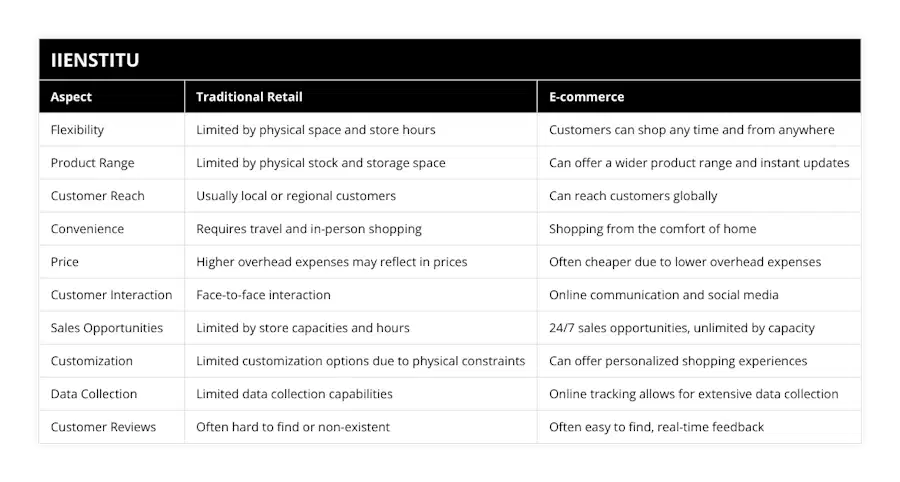
Frequently Asked Questions
What are the benefits of eCommerce over traditional retail?
Higher profit margin, less administrative costs, increased marketing opportunities, good customer service.
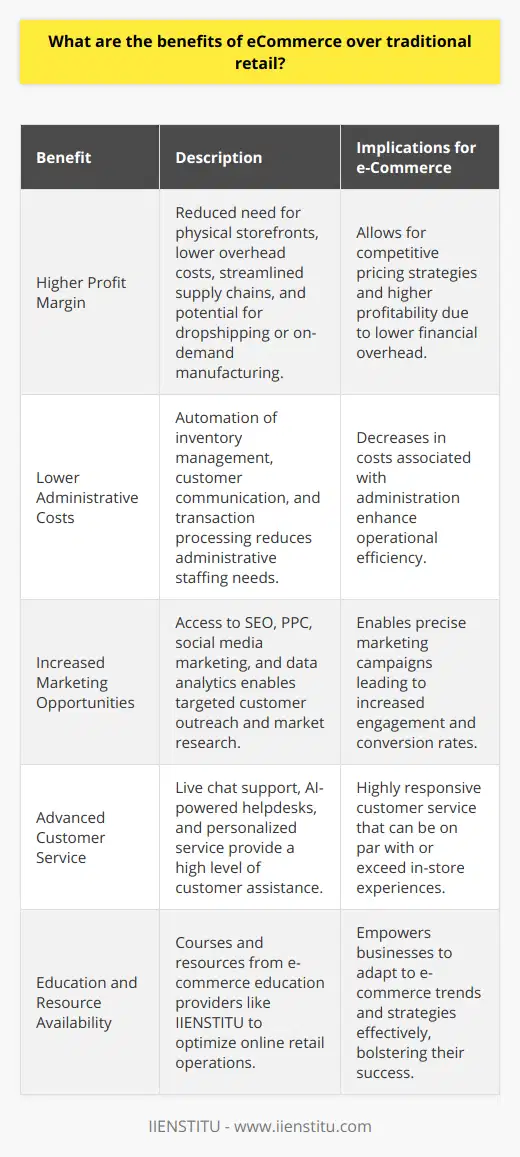
How does eCommerce change how business works?
E-commerce has revolutionized how business works. In the process, it has eliminated geographic borders and barriers to trade. Moreover, it has made it possible for increasingly smaller companies to distribute their products around the globe without significant upfront investments in physical outlets of sale, opening up global markets that were once only available to national and international conglomerates.

Is there a downside to eCommerce that we should be worried about?
The internet enables us to buy things without leaving our homes. Unfortunately, that means that fewer people need to go into physical stores, which causes many of the smaller businesses that provide jobs in these communities to close down.
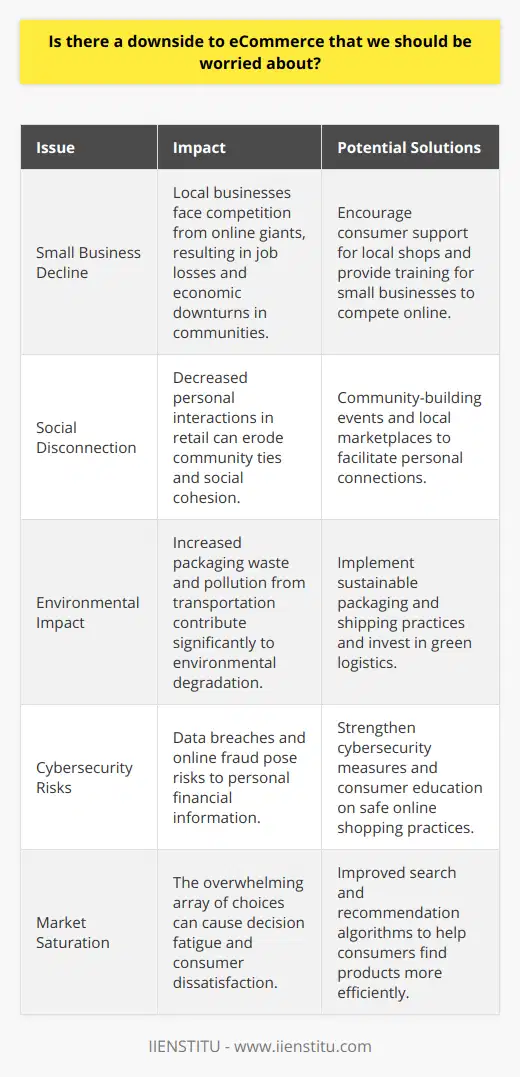
Why is e-commerce growing so rapidly and what factors contribute to this trend?
E-commerce Growth Factors
The exponential growth of e-commerce can be attributed to multiple factors that create a conducive environment for its continued expansion. Fundamentally, the ubiquity of the internet has granted businesses and consumers alike unprecedented access to a vast array of goods and services, fostering a prosperous virtual marketplace.
Convenience and Accessibility
One significant factor contributing to e-commerce growth is the convenience and accessibility it affords consumers. Online shopping eliminates the need for traveling to physical stores and offers the advantage of 24/7 availability, allowing customers to make purchases at any time and from any location with internet access. This level of flexibility effectively accommodates a wide range of consumer needs and preferences, driving further adoption of e-commerce platforms.
Shift in Consumer Behavior
Another factor behind this rapid growth is the shift in consumer behavior, as younger generations with a strong digital literacy become increasingly influential market participants. These tech-savvy consumers tend to favor e-commerce more than their predecessors, fueled by easier access to product information, reviews, and price comparisons online. This generation's inclination towards online shopping spurs businesses to enhance their digital presence.
Technological Innovations
E-commerce has also benefited from continuous technological innovations that streamline the shopping experience, bolstering consumer trust and satisfaction. For example, the widespread adoption of mobile devices has made mobile shopping increasingly popular, enabling easy access to e-commerce through dedicated apps and mobile-optimized websites. Moreover, advancements in cybersecurity and secure payment methods have reduced the risks associated with online transactions, further encouraging consumer engagement.
Improved Logistics and Delivery
Effective logistics and delivery networks are essential for e-commerce to thrive, and recent improvements in these areas have significantly contributed to its growth. Companies have invested in the development of sophisticated supply chain management systems, allowing for faster and more efficient order fulfillment, as well as real-time shipment tracking. Furthermore, the emergence of various delivery options, such as same-day or next-day delivery, has heightened consumer expectations and increased their affinity towards e-commerce.
In conclusion, the rapid growth of e-commerce can be ascribed to a combination of factors, including widespread internet access, convenience and accessibility, shifting consumer behavior, technological advancements, and improved logistics and delivery services. Each element contributes to creating a favorable environment for the continued expansion of this robust global marketplace.
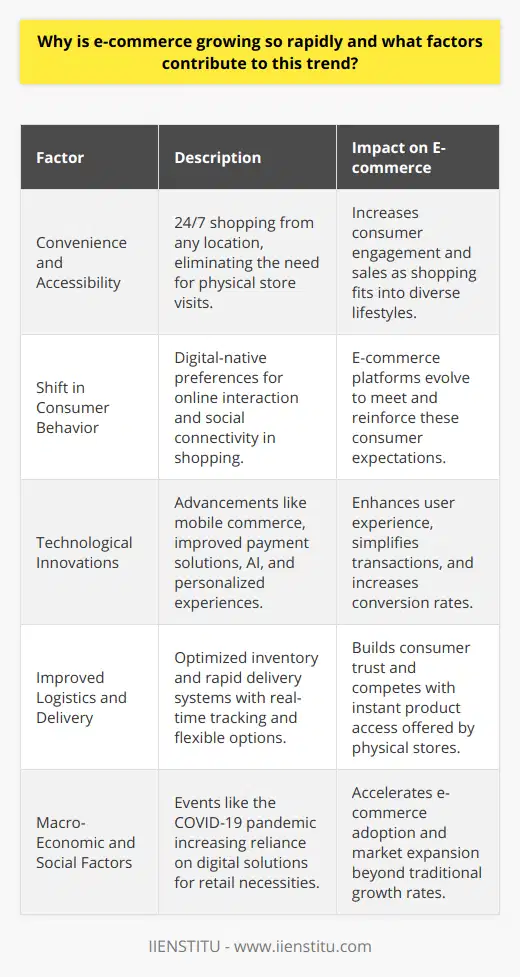
What are the key ecommerce predictions for the future, and how can businesses prepare for these changes?
Key Ecommerce Predictions
To stay ahead in the competitive ecommerce market, businesses must be aware of the key predictions shaping the industry's future. One primary prediction is a surge in AI-based technologies, enhancing functions like personalization, customer behavior analysis, and recommendation systems. Another projected trend is the increased focus on sustainability within the retail space, with consumers gravitating towards businesses incorporating eco-friendly practices into their supply chain and product offerings.
Emphasis on Mobile Commerce
The reliance on mobile devices for online shopping continues to grow, with mobile commerce expected to account for the majority of ecommerce sales in the future. Therefore, optimizing online stores for mobile devices must be a priority for businesses, allowing customers to navigate websites seamlessly, access products and services easily, and complete transactions effortlessly.
Advancements in Artificial Intelligence
To leverage AI's full potential, businesses should invest in sophisticated AI-powered tools that improve website functionality and user experience. These advancements will enable tailored shopping experiences for individual customers and help predict consumer trends more accurately. For instance, AI chatbots can offer personalized, round-the-clock customer support, while machine learning algorithms can analyze vast amounts of data to identify consumer habits, preferences, and patterns.
Sustainability as a Selling Point
As environmental concerns become increasingly prevalent, businesses need to emphasize sustainability and corporate responsibility in various aspects, from sourcing and manufacturing to packaging and shipping. Adopting sustainable practices will not only benefit the planet but also provide businesses with a unique selling point that attracts eco-conscious consumers.
Omnichannel Retail Strategies
Lastly, an effective omnichannel strategy involving seamless integration between online and offline channels is vital to cater to the evolving expectations of consumers. This includes offering buy-online-pick-up-in-store (BOPIS) services, providing personalized in-store experiences based on online browsing habits, and incorporating immersive technologies like augmented reality into brick-and-mortar stores for a cohesive shopping journey.
In summary, businesses need to adopt cutting-edge technologies, embrace sustainability, optimize mobile experiences, and execute effective omnichannel strategies to stay competitive in the rapidly evolving ecommerce landscape. Focusing on these key areas will ensure success in navigating the future changes in the market.
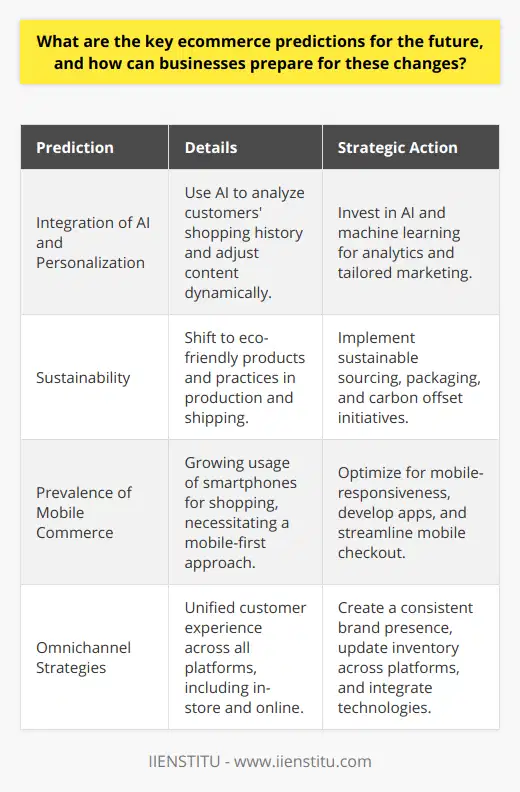
How is the increasing importance of ecommerce shaping traditional business models and consumer behavior?
Impact on Traditional Business Models
The rapid expansion of e-commerce has undoubtedly affected traditional business models by compelling them to adapt to the digital era. The once prevailing brick-and-mortar stores have experienced a significant decline due to the convenience and efficiency offered by online shopping platforms. Consequently, businesses are forced to reevaluate and reshape their strategies to remain competitive and relevant in the market.
Integration of Online and Offline Channels
One significant change brought by e-commerce is the integration of online and offline channels, also known as the omnichannel approach. This has allowed businesses to provide a seamless shopping experience for their customers by integrating their physical and digital presence. By adopting this approach, businesses can cater to a wider range of customers as they have the flexibility to choose between various purchasing methods, ultimately leading to increased sales and customer satisfaction.
Evolution of Marketing and Sales Strategies
E-commerce has also led to a shift in marketing and sales strategies. Traditional methods of advertising through billboards or print media have now been replaced by digital marketing tactics, such as social media, search engine optimization, and influencer partnerships. This change in approach allows businesses to reach their target audience more effectively and engage with them on a personal level. Furthermore, data-driven marketing has become increasingly prominent in e-commerce as businesses now have access to vast amounts of consumer data that can optimize their marketing strategies.
Consumer Behavior Shifts
The increasing importance of e-commerce has not only influenced traditional business models but also affected consumer behavior. Online shopping has created a culture of instant gratification, where customers expect speedy delivery of products and services. Additionally, the prevalence of e-commerce platforms has led to the expectation of a wide variety of choices and the ability to compare prices easily. This shift in expectations has increased competition among businesses, driving them to improve their offerings and customer service to stand out from the crowd.
Closing Remarks
In conclusion, the rise of e-commerce has significantly impacted traditional business models and consumer behavior. As businesses strive to remain competitive, they must adopt new strategies, such as omnichannel approaches and data-driven marketing, to cater to the changing needs and demands of their customers. As a result, companies that embrace these changes and continuously innovate will ultimately emerge as successful market players in the e-commerce era.

Why is ecommerce important for the future when considering global market expansion and sustainability practices?
Ecommerce and Global Market Expansion
Ecommerce plays a crucial role in the future of global market expansion, as it enables businesses to transcend geographical boundaries and tap into new markets. Through ecommerce platforms, small and medium-sized enterprises (SMEs) can reach a wider customer base, helping them grow and compete in the international market. Furthermore, ecommerce allows companies to scale their operations more efficiently, as they can manage logistics and supply chain operations digitally, which reduces the need to establish a physical presence in international markets.
Embracing Sustainable Practices
Another benefit of ecommerce is the potential to incorporate sustainable practices into business operations. Online platforms can help reduce the carbon footprint of both businesses and customers by minimizing transportation needs and streamlining the supply chain process. Additionally, ecommerce businesses can leverage digital marketing and sales efforts to reduce the consumption of paper and other non-renewable resources, ultimately contributing to a more sustainable business model.
Reducing Environmental Impact
As consumers become more environmentally conscious, ecommerce can help global businesses adapt to this changing mindset. Online stores can offer eco-friendly products and more sustainable packaging options, facilitating increased consumer engagement with sustainable consumption practices. Furthermore, the data-driven insights provided by digital platforms can support businesses in making informed decisions about their environmental impact, such as reducing overproduction and waste by better understanding consumer demand.
Promoting Social Sustainability
Ecommerce not only addresses environmental sustainability but also contributes to social sustainability. By providing a platform for small businesses to reach larger audiences, online commercial platforms can contribute to economic growth and job creation. Moreover, digital marketplaces can foster a sense of community and fair competition, where businesses can communicate, collaborate, and learn from one another.
In conclusion, ecommerce is vital for the future of global market expansion, as it enables companies to access new markets, scale their operations, and adapt to consumer preferences for sustainable practices. In addition to the environmental benefits of reducing transportation and resource consumption, ecommerce also promotes a more socially sustainable global economy, empowering small businesses to grow and compete on a global stage.
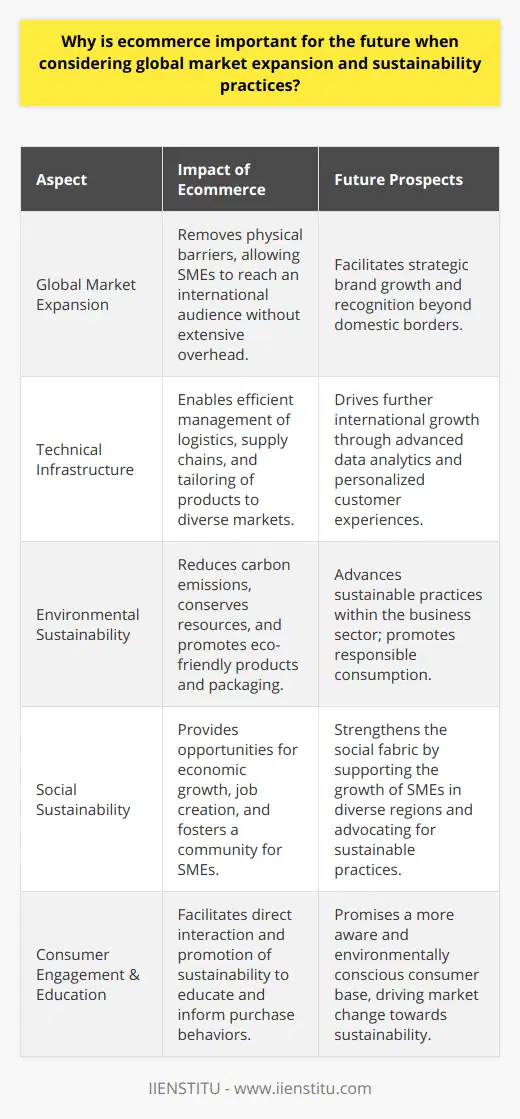
In light of the COVID-19 pandemic, why is e-commerce becoming more significant in maintaining the continuity of businesses and global economic growth?
E-commerce Role During Pandemic
The COVID-19 pandemic has dramatically altered the global economy, necessitating rapid adaptation from businesses to reduce the negative impact on growth. Within this context, e-commerce has emerged as an essential tool in maintaining business continuity and promoting economic growth. There are several reasons for this development.
Ease of Access and Transactions
Firstly, e-commerce platforms provide customers with a convenient and safe way to access goods and services without risking COVID-19 exposure. Consequently, businesses can cater to existing customers, reach a wider audience, and maintain cash flow as an alternative to brick-and-mortar outlets.
Business Adaptation and Survival
Secondly, e-commerce enables businesses to swiftly modify their operational models to adapt to the changing environment. By establishing a digital presence and reorienting towards online sales, businesses can successfully navigate economic challenges, secure their survival, and minimize job losses.
Global Market Reach
Additionally, e-commerce facilitates access to global markets for small and medium-sized enterprises, enabling them to expand their customer base and stimulate revenue growth. As a result, economic growth might be further strengthened as businesses gain more diverse and extensive reach, even amidst travel restrictions.
Supply Chain Resilience
Furthermore, e-commerce strengthens supply chain resilience by increasing efficiency and reducing dependency on physical movement of goods. Digital platforms can streamline communication and coordination between suppliers, manufacturers, and retailers, minimizing disruptions caused by pandemics or other crises.
Innovation and Competition
Finally, the accelerated adoption of e-commerce promotes the development of new technologies and fosters intense market competition, both of which can spur innovation and economic growth. Firms that can harness digital tools effectively will gain a competitive edge, encouraging others to keep pace and adapt to remain relevant.
Conclusion
In conclusion, e-commerce serves as a powerful catalyst for supporting business continuity and global economic growth throughout the COVID-19 pandemic. By providing a safe, efficient, and accessible environment for conducting business, e-commerce facilitates adaptation and innovation, ultimately enhancing the resilience of economies worldwide in times of crisis.

Considering evolving consumer preferences and technological advancements, what are the anticipated trends and innovations in the future state of ecommerce?
Evolving Consumer Preferences
As consumer preferences continue to evolve, the future of ecommerce will likely be focused on personalized and seamless shopping experiences. Advanced technologies such as artificial intelligence, personalized marketing, and smart analytics are expected to be at the forefront of these developments. By analyzing user behavior and preferences, online retailers will be able to tailor their offerings to match individual needs and expectations, thus ensuring a more customized and memorable shopping experience.
Advancements in Technology
Technological advancements are also anticipated to shape the future of ecommerce, with the integration of new and emerging technologies, such as virtual and augmented reality, 3D printing, and the Internet of Things (IoT). Virtual and augmented reality, for instance, can enhance customers' shopping experiences by allowing them to visualize and test products in a more realistic and immersive environment. 3D printing, on the other hand, can revolutionize product manufacturing and delivery, allowing customers to purchase and receive customized products with shorter waiting times.
IoT and Smart Devices
The Internet of Things (IoT) and smart devices are expected to play a significant role in redefining the ecommerce landscape. As these devices become more prevalent, companies can leverage them to create more convenient and connected shopping experiences. For example, smart appliances, such as refrigerators and washing machines, could automatically reorder necessary supplies and household staples when they run low, streamlining the shopping process for consumers.
Mobile Commerce and Social Media Integration
As mobile devices continue to dominate consumers' lives, mobile commerce is also expected to continue its rapid growth. This trend will likely encourage ecommerce retailers to optimize their websites for mobile devices and utilize additional avenues, such as apps and social media platforms, for reaching and engaging their target audience. By leveraging social media platforms, online retailers can readily connect with their customers, inspire brand loyalty and drive higher conversion rates.
Payment and Delivery Innovations
In the future, ecommerce is anticipated to incorporate innovative payment and delivery solutions, such as the use of cryptocurrencies, digital wallets, and drone deliveries. These advancements will provide customers with a wider range of options and further enhance the overall shopping experience, making it quicker, more secure, and more convenient.
In summary, evolving consumer preferences and technological advancements are expected to drive significant changes and innovations in the future of ecommerce. Personalized shopping experiences, the integration of new technologies, mobile commerce, and innovative payment and delivery solutions will undoubtedly shape the way consumers interact with online retailers and redefine the ecommerce industry as we know it today.

Why is e-commerce integral to the future success of businesses across various industries?
The Importance of E-Commerce in Business Growth
Undoubtedly, e-commerce has emerged as a powerful tool for businesses across various industries. The flexibility and convenience it offers in terms of purchase, sales, and distribution have made it an integral component for the future success of businesses.
Global Reach of E-Commerce
One of the most significant aspects of e-commerce is its ability to expand a business's reach beyond local or regional boundaries, helping them tap into international markets. This not only increases the firms' customer base but also opens up opportunities for a higher revenue generation.
Personalized Customer Experience
E-commerce platforms allow businesses to provide personalized experiences to customers, based on their preferences and purchase history. This fosters stronger customer relationships and increases customer retention, contributing to long-term business success.
Cost-Effective Operations
E-commerce platforms enable businesses to streamline and automate various operations, making them more cost-effective. They help reduce overhead costs such as rent, storage, and inventory management, allowing businesses to allocate resources to other areas of growth.
Data-Driven Decision Making
The use of e-commerce platforms allows businesses access to real-time data related to customer preferences, sales trends, and supply chain performance. This data-driven approach enables businesses to make informed decisions on product development, marketing strategies, and expanding their market share.
Innovation and Adaptability
E-commerce promotes innovation as businesses need to continuously adapt and evolve to stay competitive in the digital marketplace. Integrating emerging technologies, such as AI-driven personalization and voice search, into the e-commerce ecosystem contributes to the continuous improvement of user experience and overall business growth.
In conclusion, embracing e-commerce is crucial for businesses to thrive and succeed in a rapidly changing and increasingly digital landscape. Through the leveraging of global reach, personalized customer experiences, cost-effective operations, data-driven decision making, and continuous innovation, e-commerce ensures that businesses can stay competitive, while delivering customer satisfaction and boosting revenue.

In what ways will the future state of ecommerce necessitate adaptations in supply chain management and logistical processes?
Supply Chain Adaptations
The future state of ecommerce will require significant adaptations in supply chain management and logistical processes. One key factor driving this change is the increasing customer demand for faster and more efficient delivery. To meet these expectations, supply chains must evolve to become increasingly agile and responsive. This includes adopting technologies such as big data analytics, machine learning, and IoT devices for real-time monitoring and decision-making.
Advanced Data Analytics
Another adaptation will involve leveraging advanced data analytics to forecast consumer buying trends, optimize inventory levels, and reduce lead times. For example, the use of machine learning can enable businesses to analyze massive amounts of data from multiple sources, helping them identify patterns and trends in consumer behavior. This will enable companies to manage stocks more efficiently and avoid costly stockouts or excess inventory.
Integration of Automation
Ecommerce growth will also necessitate the integration of automation in logistical processes for faster and more efficient delivery of products. Automated vehicles, drones, and robotics could play crucial roles in designing smart, cost-effective, and environmentally sustainable solutions for transportation and warehousing. This would be especially relevant in areas where traditional delivery systems are less efficient or face resource constraints.
Sustainable Practices
Sustainability will be another crucial aspect of supply chain management in the future of ecommerce. In an increasingly eco-conscious world, businesses need to adopt practices that minimize environmental impact and reduce carbon emissions. This can include optimizing transportation routes and schedules, using eco-friendly materials in packaging, and recycling initiatives to manage waste.
In Conclusion
In summary, the future state of ecommerce will necessitate significant adaptations in supply chain management and logistical processes. This will involve increased adoption of advanced technology and data analytics, integration of automation and robotics, and a focus on sustainability. Together, these adaptations will enable businesses to meet growing customer demands while minimizing environmental impact and operating costs.
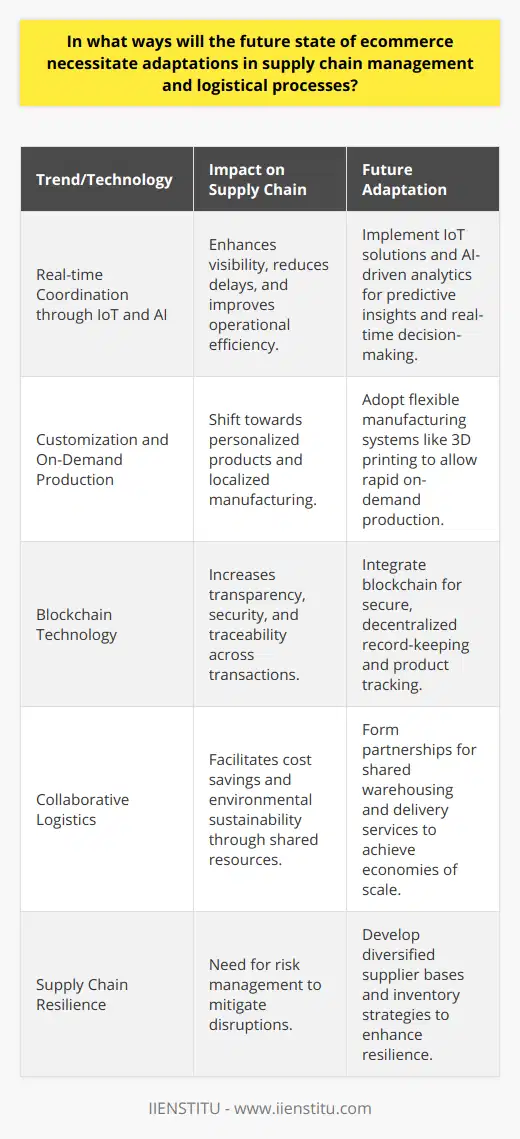
How might advancements in emerging technologies, such as artificial intelligence and virtual reality, influence the growth trajectory and success of e-commerce in the years to come?
Impact on Consumer Experience
As emerging technologies like artificial intelligence (AI) and virtual reality (VR) continue to advance, they will significantly influence the growth and success of e-commerce. One notable aspect is the improvement in consumer experience. AI-based chatbots, for instance, enable faster and more personalized customer support, while VR technologies allow for immersive shopping experiences that replicate physical store visits. By offering more convenient and engaging ways to shop, e-commerce companies can attract new customers and retain existing ones, thereby boosting sales and market share.
Facilitating Accurate Data Analysis
Advanced data analytics powered by AI can further contribute to e-commerce success. Algorithms can process vast amounts of information from customer interactions, browsing habits, and social media engagements. This data-driven analysis helps businesses better understand their clients, identify trends and patterns, and make more informed decisions about product offerings and marketing strategies. As a result, e-commerce companies with access to these insights will be better equipped to meet customer expectations, leading to increased revenues and market shares.
Promoting Efficient Logistics and Inventory Management
AI and other emerging technologies can also optimize logistic operations and inventory management in the e-commerce sector. Through machine learning algorithms, businesses can track supply chain events in real-time and predict fluctuations in demand. This enables e-commerce companies to maintain optimal inventory levels, minimize storage and transportation costs, and reduce potential loss from overstocking or stockouts. By streamlining these processes and enhancing operational efficiency, e-commerce enterprises stand to increase profitability and gain a competitive edge in the market.
Enhancing Security and Trust
Furthermore, AI-driven security measures can increase consumer trust in e-commerce platforms. Sophisticated algorithms can detect and prevent fraudulent activities and help in securing financial transactions. As customers become more confident in the safety of their online transactions, e-commerce platforms can expect increased traffic and conversion rates, propelling their growth trajectory.
In conclusion, advancements in artificial intelligence, virtual reality, and other emerging technologies are poised to transform the e-commerce landscape. By improving user experience, facilitating accurate data analysis, promoting efficient logistics and inventory management, and enhancing security and trust, these innovations will significantly influence the growth trajectory and success of e-commerce in the years to come.

Why is e-commerce important in the future for addressing the needs of an increasingly digitized and connected global population?
E-Commerce as a Solution for Global Digital Populations
The Significance of E-Commerce
In the foreseeable future, e-commerce will emerge as an indispensable platform for catering to the demands of an ever-expanding digital populace. This significance stems from the rapid advancements in technology, which have transformed the way people conduct business, connect with each other, and access information.
Driving Factors for E-Commerce Growth
A primary driving factor behind the evolution of e-commerce is the growth in global internet penetration. The proliferation of smartphones, tablets, and other mobile devices has facilitated increased online access to goods and services. Additionally, the rise of social media platforms has contributed to the globalization of online marketplaces, enabling businesses to reach a diverse clientele spread across geographical boundaries.
Addressing Consumers' Needs
E-commerce platforms are equipped to bridge the gap between businesses and consumers in an increasingly digitized world. They offer convenience, flexibility, and cost-effectiveness, as they enable shoppers to access products and services from the comfort of their homes. As a result, consumers benefit from personalized shopping experiences, a diverse range of products, and the ability to compare prices and ratings.
Fostering Sustainable Business Practices
Moreover, e-commerce promotes the adoption of sustainable business practices, as it encourages businesses to minimize their carbon footprint by reducing waste, energy consumption, and production costs. By embracing digitized payment systems and using analytics to optimize inventory management, companies can contribute to a more sustainable and eco-friendly global economy.
Supporting SME's and Job Creation
Another crucial aspect of e-commerce is its potential to bolster the growth of small and medium-sized enterprises (SMEs) and foster job creation. With easier market access and the ability to scale operations at a lower cost, e-commerce provides opportunities for SMEs to expand their reach and generate employment opportunities.
In conclusion, the importance of e-commerce in addressing the needs of a globally connected and digital population cannot be understated. As technology continues to advance, e-commerce will play a pivotal role in meeting consumer demands, fostering sustainable business practices and driving economic growth by offering increased opportunities for SMEs and job creation.

How is ecommerce expected to contribute to the transition towards a more sustainable and environmentally conscious economy?
Ecommerce and the Sustainable Economy
Environmental Benefits of Ecommerce
Ecommerce is expected to contribute significantly to the global transition towards a more sustainable and environmentally conscious economy. A key aspect of this contribution lies in its ability to reduce the environmental impact of traditional retail. By operating online, ecommerce businesses can reduce their carbon footprint by using less energy for heating, lighting, and air conditioning than brick-and-mortar stores.
Reduced Transport Emissions
Moreover, ecommerce facilitates a decline in transport emissions through logistics optimization. Online retailers can more effectively consolidate shipments for delivery, which results in fewer individual trips and lower greenhouse gas emissions. As a direct consequence, there is less need for large fleets of vehicles and infrastructure, leading to a decrease in urban congestion and pollution.
Promoting Green Products
Ecommerce also encourages sustainability when consumers can easily find and buy environmentally friendly products from a wider range of suppliers. By offering informative content, engaging in eco-friendly practices, and promoting sustainable products, online retailers contribute to raising awareness and increasing demand for environmentally conscious consumption.
Waste Reduction
Another way ecommerce contributes to a more sustainable economy is by reducing waste. Digital transactions and electronic invoices eliminate the need for paper receipts, while streamlined inventory management minimizes excessive product returns and packaging waste. Additionally, ecommerce allows for on-demand production, meaning that items are produced only when they are needed, reducing the amount of surplus merchandise and the risk of overproduction.
Circular Economy Opportunities
Lastly, ecommerce can potentially accelerate the transition towards a circular economy. Online platforms can boost the resale market, enabling consumers to buy second-hand items or sell their gently-used products, thus extending the life cycle of goods and reducing waste. Furthermore, ecommerce enables innovative, sustainable business models, such as product-as-a-service and sharing economy platforms, which contribute to the conservation of resources and promote sustainable consumption.
In conclusion, ecommerce is expected to play a major role in the global shift towards a more sustainable and environmentally conscious economy. By reducing the environmental impact of traditional retail, optimizing logistics, promoting green products, reducing waste, and fostering circular economy opportunities, ecommerce can considerably contribute to the protection of our planet and the achievement of global sustainability goals.
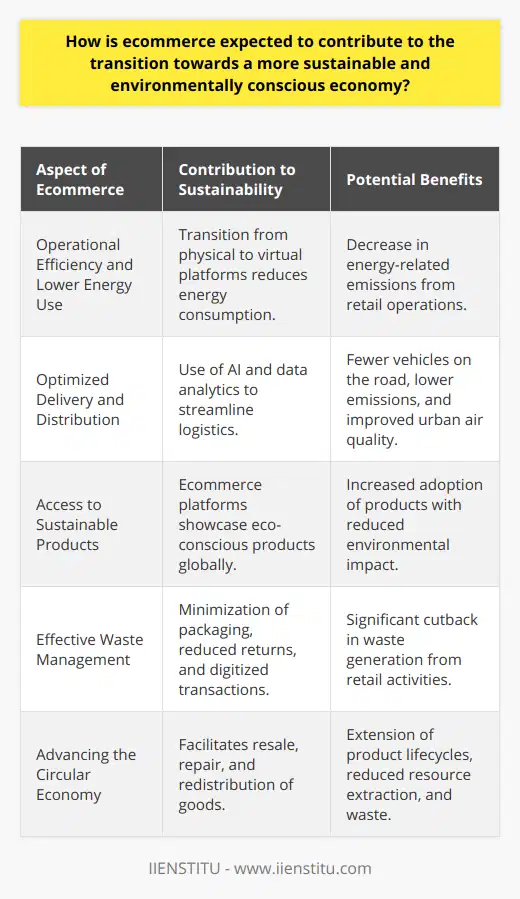
In what ways is the widespread growth of e-commerce expected to affect labor markets and employment opportunities in various industries and regions?
Impact on Labor Markets
In recent years, the rapid expansion of e-commerce has significantly impacted labor markets and employment opportunities across various industries and regions. One major aspect of this influence is the growth in demand for skilled professionals in fields related to e-commerce, such as IT, logistics, digital marketing, and data analysis. As companies increasingly rely on online platforms to reach customers and expand their businesses, more jobs are generated for those with the capabilities to support such ventures.
Shift in Employment Opportunities
An emerging trend in the labor market is the shift from traditional retail and service jobs to positions that emphasize technological skills and online capabilities. Brick-and-mortar store employees are finding themselves in need of adapting to or learning digital skills to stay relevant in this e-commerce-driven environment. Furthermore, temporary and freelance work opportunities (also known as gig economy) are on the rise in the e-commerce sector as businesses require flexible workers to adapt to the fluctuations in consumer demand.
Region-wise Influence
As e-commerce activity yields differences across regions, so do its effects on employment. In developed countries with well-established internet infrastructure, greater access to technology has accelerated the growth of e-commerce, thereby fostering job creation opportunities in various related industries. On the other hand, developing countries may encounter a lag in e-commerce expansion, leading to slower job growth in their respective regions. This digital divide contributes to the unequal distribution of e-commerce employment opportunities across the globe.
Automation and Job Displacement
While the expansion of e-commerce generates job opportunities, it is worth noting that the increasing prevalence of automation and artificial intelligence (AI) may also result in job displacement. Automated processes in e-commerce, such as chatbots for customer support and robots for warehouse management, are expected to reduce the need for manual labor. Consequently, this automation trend may lead to job losses for those in routine-based roles. Nonetheless, it is also anticipated to stimulate job creation in more specialized domains that require human skills and expertise.
In conclusion, the widespread growth of e-commerce is expected to significantly affect labor markets and employment opportunities in various industries and regions. The demand for skilled professionals in e-commerce-related fields has increased, and there has been a shift from traditional jobs towards technology-oriented roles. Differences in regional e-commerce growth and the prevalence of automation and AI are also important factors influencing the labor market outcomes in this evolving landscape.
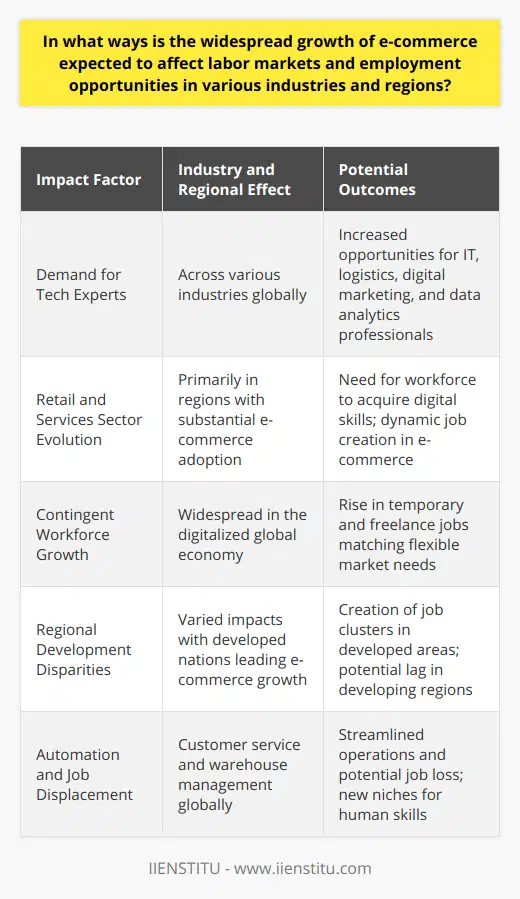
Is e-commerce the future, and how might it help address issues like climate change, resource scarcity, and income inequality?
E-commerce as the Future
E-commerce holds enormous potential in addressing socio-economic issues and environmental challenges. Firstly, we must admit that e-commerce has become a significant contributor to global economic growth. The recent pandemic further solidified its place as the business model of the future.
Mitigating Climate Change through E-commerce
E-commerce can contribute to climate change mitigation plans. Traditional brick-and-mortar stores require physical infrastructure and energy use that generate significant greenhouse gas emissions. On the contrary, e-commerce runs mostly on digital platforms, which lessen physical space needs, hence essentially reducing carbon footprints.
Addressing Resource Scarcity
The digital nature of e-commerce can tackle resource scarcity issues. Digitalization decreases reliance on natural resources, as it promotes paperless transactions and lessens the need for tangible goods. Hence, this transition preserves resources for other essential, more sustainable use.
E-commerce and Income Inequality
Income inequality is a pressing issue that e-commerce can alleviate. Offering an all-inclusive platform, e-commerce gives smaller businesses a chance to compete with larger firms in the global market. Thus, it promotes fair trade practices, creating vast opportunities for income growth across various economic strata.
Furthermore, e-commerce fosters job creation in multiple areas like digital marketing, logistics, customer support, and web development. These new jobs offer better remuneration than traditional retail positions, combatting income disparity.
In conclusion, the rise of e-commerce is more than a tech-savvy trend; it's an instrument of socio-economic progression and environmental sustainability. As we transition towards this digital economy, we should harness its extensive potential for global development while also addressing its significant challenges.
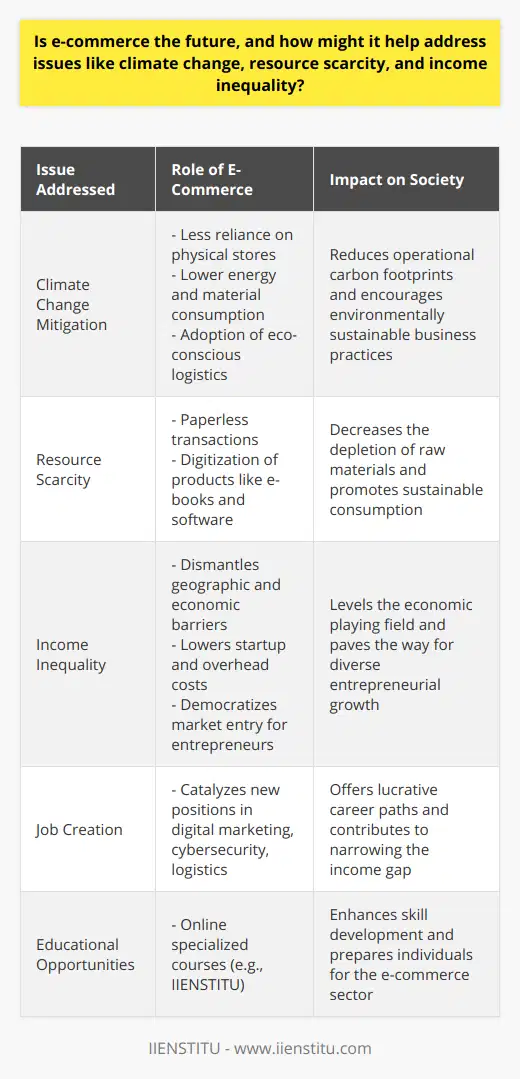
Why is the e-commerce industry growing at such an accelerated pace, and what implications does this have for businesses in various sectors and regions?
Accelerating E-commerce Growth
The e-commerce industry's rapid growth stems from technology applications and shifting consumer behaviors. Advancements in digital technology ease online shopping, enhancing consumer's purchasing experiences. For instance, Artificial Intelligence, Machine Learning, and Big Data contribute to creating personalized shopping experiences. Further, the COVID-19 pandemic acted as a catalyst, making digital platforms a safe and convenient shopping alternative.
Digital Platforms and Consumer Behavior
Moreover, consumers are now more comfortable shopping online due to easy access to reviews and product comparisons. With smartphones being ubiquitous, online shopping has become incredibly accessible even in remote regions. Hence, e-commerce transcends physical boundaries, enabling brands to reach global audiences.
Implications for Various Sectors
Therefore, the e-commerce boom has profound implications across diverse sectors. Retailers face the most notable impact with the soaring trend of online shopping. Traditional retail businesses must either integrate e-commerce strategies or risk becoming obsolete.
Industries like real estate and construction also get affected. The surge in e-commerce reduces the demand for physical retail spaces, impacting these sectors. Similarly, delivery and logistics sectors are experiencing a growth spurt due to increased demand for last-mile delivery services.
Regional Differences in E-commerce Impact
Geographically, the impact varies. Developed countries with solid infrastructure and internet penetration witness faster e-commerce growth. Developing nations, despite the slower pace, record substantial growth numbers, driven by increasing internet access and growing smartphone usage.
In conclusion, the accelerated growth of e-commerce is influenced by both digital technology evolution and changes in consumer behaviors. Sector-wise, it presents profound challenges and opportunities, requiring businesses to adapt to this digital transformation. Regionally, it offers extensive business expansion potential, with unique growth dynamics in different countries.
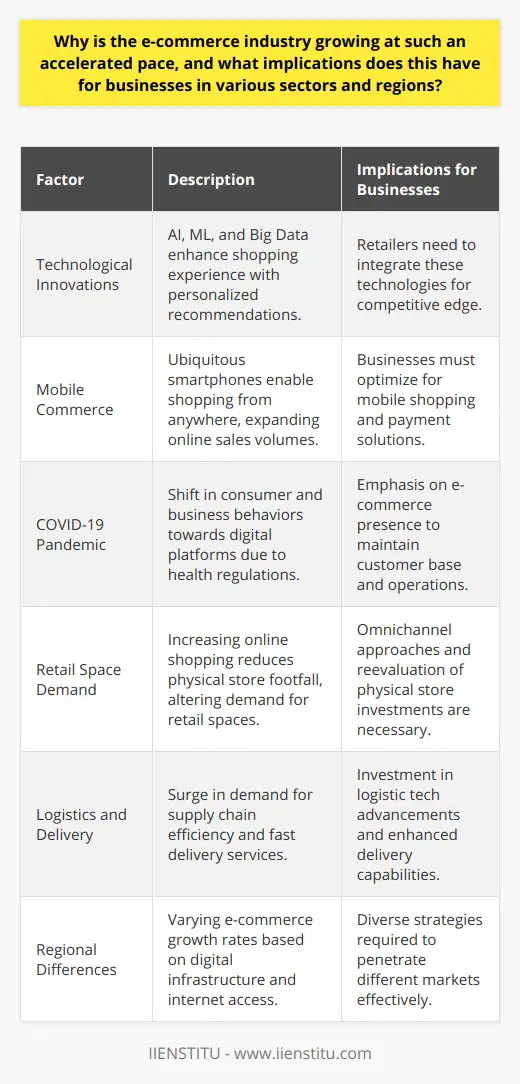
Is eCommerce still worth it in 2023, considering potential changes in tax regulations, competition, and consumers' attitudes towards online shopping?
Ecommerce Viability in 2023
Analyzing the potential of ecommerce in 2023, we must consider three primary dimensions: tax regulations, competition, and consumer attitudes.
Evolving Tax Regulations
Concerning tax regulations, every business sector navigates evolving rules as economies grow and transform. Although new tax regulations may pose challenges, they rarely deter business endeavors. Adequate planning and informed decision-making can offset these changes to maintain profitability. Thus, potential tax changes are unlikely to significantly impact ecommerce's viability.
The Intensity of Competition
Intense competition in ecommerce is a reality. Nevertheless, competition is a universal business concern, not a drawback unique to ecommerce. Businesses can remain competitive through continuous innovation, understanding consumer needs, and providing superior customer experiences. The success of giants like Amazon and Alibaba confirms it is possible to thrive despite intense competition.
Shifts in Consumer Attitudes
Understanding consumer attitudes is key. Indeed, consumers increasingly favor online shopping due to its convenience, price comparisons, and wide product range. Reports predict that global ecommerce sales will reach $6.54 trillion by 2023, reflecting this preference shift. Moreover, as digital natives – those born into the digital age – become significant spending cohorts, the demand for ecommerce will likely increase.
To conclude, despite tax regulations and intense competition, the projected rise in ecommerce sales indicates that ecommerce remains an attractive business venture in 2023. However, businesses must continually innovate, understand evolving consumer needs, and make informed decisions to remain profitable and competitive.

Is e-commerce the future, and if so, what role will it play in addressing pressing global challenges such as increasing digital divides and fostering inclusive economic growth?
E-Commerce and The Future
Undeniably, e-commerce will play a pivotal role in shaping the future, particularly in managing digital divides and promoting inclusive economic growth. The dynamic digital landscape continues to catapult e-commerce into unprecedented prominence. In fact, numerous industries now greatly depend on online transactions.
Tackling Digital Divides
E-commerce could help address the increasing digital divide as it fosters an environment that necessitates digital literacy and inclusion. The existence of this divide, distinguishing those who have access to digital technologies and those who don't, can hinder economic and social progression. By generating demand for digital skills and resources, e-commerce can increase incentives for universal digital education and infrastructure.
Addressing economic inclusion through e-commerce.
E-commerce bears the potential to break down barriers to economic participation. For instance, it offers small-scale producers and entrepreneurs a wider market reach, ultimately fostering inclusive growth. By reducing access hurdles, e-commerce can democratize the economy, stimulate competition, and encourage innovation.
However, e-commerce's capacity to address global challenges is not without limitations. Unregulated environments can lead to market monopolies and unbalanced power dynamics, thus highlighting the need for robust policy-making. This involves fostering digital literacy, enforcing data protection regulations and implementing fair competition laws.
In conclusion, while e-commerce indeed represents a vital part of the future, its positive influence on global challenges relies heavily on the proper governance of digital markets. Hence, integrating e-commerce into strategies for global development necessitates a collaborative commitment from stakeholders across all sectors.

Why is e-commerce becoming important, particularly in terms of enabling businesses to adapt to shifts in consumer preferences and technological advancements?
Rising Significance of E-Commerce
The ascendance of e-commerce in the business sector has largely been due to evolving customer preferences and technological advancements. A primary reason is the shift in consumer behavior towards online shopping. Internet users have been increasing rapidly, and with it, the convenience of online shopping has spurred a change in purchasing habits.
Adaptation to Consumer Preferences
Customers now prefer to explore, compare and purchase products at their own pace without geographical constraints. E-commerce caters to this by providing a platform to shop from anywhere and at any time. It reaches out to a global audience and breaks the barriers of time and location, increasing the potential customer base for businesses.
Leveraging Technological Advancements
Moreover, technological innovation increasingly influences the growth of e-commerce. The advent of mobile technology has further expedited this growth. With the majority of internet users now accessing the web through their smartphones, mobile commerce has become a dominant subset of e-commerce. Businesses can enhance their reach by providing mobile-friendly interfaces and applications, catering to the ever-growing smartphone user population.
Driving Business Growth
E-commerce, thus, has become vital for businesses to stay relevant and competitive in the digital era. Businesses that can adapt their operations to an online model can leverage these changing consumer preferences and technological advancements. In doing so, they can open up new revenue streams, expand their customer base, and boost their overall growth.
In conclusion, the importance of e-commerce has become more pronounced due to shifts in consumer behavior and advancements in technology. By enabling businesses to adapt to these changes in a timely manner, e-commerce has emerged as a significant driver of growth in the modern business landscape.

Why is the e-commerce industry growing at an unprecedented rate, and how might this trend impact traditional retail markets, international trade dynamics, and overall economic stability?
Growth Drivers of E-commerce
The e-commerce industry finds its growth from several sources. Key among these is the emergence of sophisticated technology. Easy access to the internet and digital devices has made online shopping compellingly convenient. Changing consumer behavior also plays a big role. People are increasingly prioritizing comfort and time efficiency. They now prefer shopping at a click from the comfort of their homes.
Impact on Traditional Retail Markets
The surge in e-commerce is placing substantial pressure on traditional retail markets. Brick-and-mortar stores are facing stiff competition as more people opt for online purchases. Sales figures for physical stores are witnessing a downward trend. The traditional retailers have to rethink their strategies to sustain in the heightened competitive environment.
Implications for International Trade Dynamics
The e-commerce boom has significant implications for international trade dynamics. Many online trading platforms allow international shopping. This has created opportunities for businesses to access global markets with ease. On the flip side, it introduces intense competition among businesses across borders.
Effect on Economic Stability
The e-commerce boom can both foster and disrupt economic stability. On one hand, it can generate substantial revenue and job opportunities, contributing to economic growth. On the other hand, an increase in cross-border trade may lead to disparities, affecting domestic industries adversely. The economic policies need an overhaul to handle these implications effectively.
Overall, the e-commerce industry is revolutionizing global trade, affecting various facets of the economy. However, the prospective challenges it brings cannot be ignored. For a balanced growth environment, a comprehensive approach is required to capitalize on its benefits while mitigating potential risks.
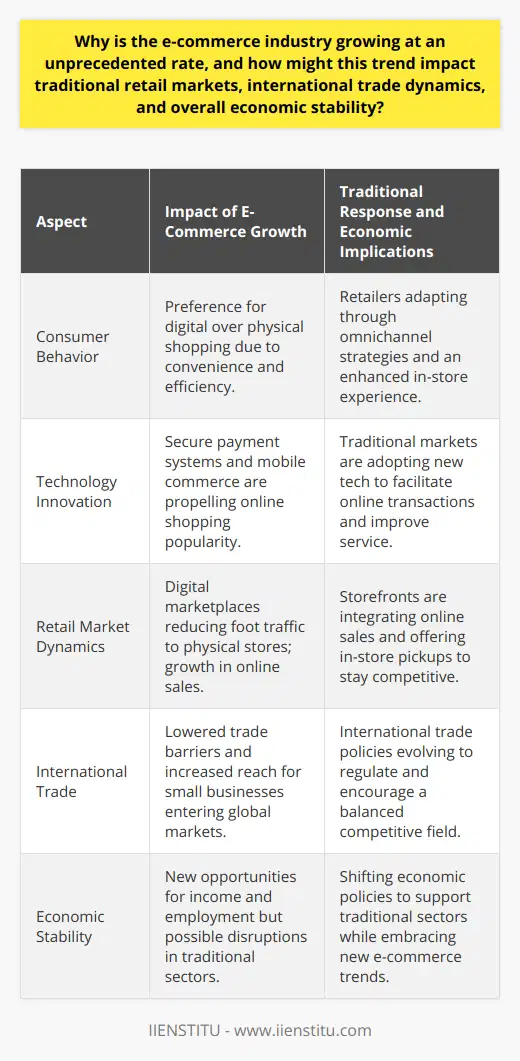
Is e-commerce the future and if so, how can it support the development of more inclusive and equitable economic systems worldwide?
E-Commerce and Inclusive Economies
Yes, e-commerce is unequivocally the future. It evolves our traditional economic systems towards more inclusive and equitable models.
Inclusive Growth
E-commerce permits universal participation. Regardless of geographical location, any person with internet access can engage in business transactions. This democratizes the entire business landscape and promotes economic inclusion.
Equal Access to Markets
E-commerce presents an opportunity for equal access to markets. It eliminates the barrier of physical location, allowing small businesses and entrepreneurs to compete with larger enterprises. In doing so, it fosters a fair and competitive business environment.
Supporting Developing Economies
E-commerce also plays a crucial role in supporting the growth of developing economies. It offers a platform for emerging markets to reach a wider customer base, thus generating higher revenues and ultimately contributing to the nation's GDP.
Increased Job Opportunities
Furthermore, e-commerce is a rich source of job opportunities. A thriving online marketplace requires a myriad of roles, from digital marketers and web developers to logistics personnel, providing employment across several sectors.
Enhanced Economic Security
Finally, e-commerce contributes to economic security. A thriving and equitable online marketplace can stimulate competition, maintain stability in prices, and promote customer satisfaction, leading to a robust economy.
In conclusion, e-commerce not only suggests a more inclusive and equitable economic future, but it is also a crucial catalyst in the development of such systems. Therefore, adopting and promoting e-commerce practices can pave the way for a globally equitable economic advancement.

Why is e-commerce becoming important, especially in relation to facilitating cross-border trade and fostering economic growth in developing countries?
Integration of E-commerce in Developing Economies
E-commerce has graduated from being simply convenient to becoming an essential facet of global trade. Its transformative role, especially in developing economies, cannot be overstated.
Catalyst for Cross-Border Trade
E-commerce mitigates geographical and time barriers between customers and vendors. It fosters cross-border trade by enabling access to global markets at drastically reduced costs. Therefore, even small and medium-scale enterprises can compete in the international arena.
Economic Growth Engine
E-commerce acts as a catalyst for economic growth in developing countries. It creates job opportunities, enhances competition and drives innovation. It potentially helps to diversify economies, moving them away from dependency on a few export commodities.
Digital Inclusion Promotes Participation
Moreover, e-commerce promotes digital inclusion. As more people gain internet access, more can participate in e-commerce. This enhances local entrepreneurship, innovation and consumer choice, further fueling economic growth.
Reduced Transaction Costs
Through e-commerce, businesses dodge the often high operational costs associated with running brick-and-mortar stores. These savings may indicate greater profitability and more sustainable business models.
To sum up, e-commerce is crucial for facilitating cross-border trade and fostering economic growth in developing countries. Its importance cannot be underestimated in our rapidly digitizing global economy. As such, harnessing its potential should be a priority for developing economies.

Why is the e-commerce industry growing so rapidly, and how might this trend affect governmental policies and regulations surrounding international trade, taxation, and consumer protection?
E-commerce Growth Drivers
The e-commerce industry is experiencing rapid growth due to the convenience it offers, high-speed internet access, and increased consumer trust in online transactions. Technological advancements have made it easier for businesses to offer personalized services, thus incentivizing online purchases.
Impact on Government Policies
Such growth could influence international trade policies as governments attempt to regulate digital transactions. Stringent rules might be instituted to ensure the smooth operation of such trades, minimize fraud, and protect consumer privacy. Trade agreements may have to be revised to incorporate digital commerce, leading to changes in related laws.
Effect on Tax Regulations
Rapid e-commerce growth could stir changes in tax regulations. Governments may introduce digital tax laws to ensure companies pay their fair proportion. This could lead to increased tax income but may also raise debates about multinational corporations' duties, given their global reach and the location-independence of digital transactions.
Influence on Consumer Protection
In terms of consumer protection, online trade growth may lead to the development of broader, more robust policies. As the industry expands, governments are likely to strengthen and enforce consumer rights for online transactions. They might have to create regulations to curb false advertising and to ensure the fairness of terms and conditions.
In conclusion, the growth in e-commerce could drive significant reforms in international trade, taxation, and consumer protection policies. As the digital landscape continues to evolve, governments worldwide will need to adapt to protect economic interests and consumer rights.



